|
This kit review covers 1/72-scale models kits of three
variants of WW2 era Japanese Army Type 95 light reconnaissance tank,
produced from 1936 to 1943 but serving till the war’s end in
1945, and afterwards with Korean and Chinese forces. At 2300 produced
this was the most common Japanese AFV. Reviewers consider it adequate
to above average for its class in its early years, but totally inadequate
for combating other tanks by 1944.
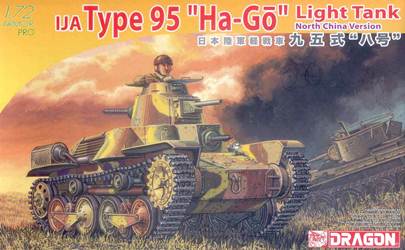
- This
particular version (kit 7402) represents a type serving in Manchuria
(North China) that was occupied by Imperial Japan in the 1930’s
and 1940’s. Checking out the box art we can see what we are
supposed to have in the box. Starting at the top we have a commander
figure viewing the battlefield out the split-hatch cupola. We see
small vision slits around the cupola. No commander figure is included
in the kit, which is too bad.
- The
37-mm main gun is visible. There is no coaxial machine gun but a
machine gun mounted out the turret rear in about the 5 O’clock
position.
- The
turret and the hull appear to be of riveted construction, not welded.
- On
the hull we see the driver’s viewport on the vehicle’s
right (our left) with his viewport hatch closed, then the hull machine
gun mount on the vehicle’s left. At the rear of the upper
hull is the engine muffler mounted on the mudguard and an engine
vent to its right.
- There
are four rubber tired roadwheels mounted on two bogie assemblies.
The sprocket drive wheel is at the front with an idler wheel in
the back.
- The
Type 95 is depicted painted in a four-color camouflage scheme. I
see no unit or vehicle markings.
- Based
on the presence of the immobilized Soviet BT-7 tank at the far right
I interpret this to represent combat in the Battle of Khalkhin Gol
(Nomonhan) in Manchuria, 1939, where the Imperial Japanese Army
forces were trounced by a Soviet Army.
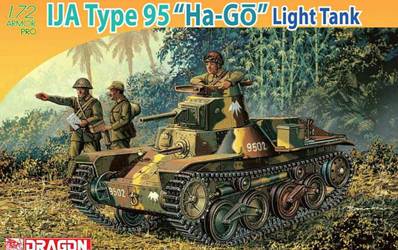
- The
above box art is Dragon’s first release of their Type 95 light,
three-person tank kit. The painting represents a tank of the 2nd
Company 7th Tank Regiment of the Imperial Japanese Army, serving
in the Philippines in 1942. This is the only vehicle marking included
within the kit, other markings (such as on Saipan, in Burma, or
with Japanese Naval unit forces) would be greatly appreciated.
- The
tank is painted in a three-color camouflage scheme, including bright
yellow stripes common to many Japanese tanks of the time period.
On the side and the front are a vehicle number and a white flower-like
marking.
- There
are two infantry figures and one tank crew figure portrayed, but
there are no figures included within the kit. Too bad.
- It
took me a little while to try and notice the difference between
this Type 95 and the North China version: it is in the bell crank
(bogie) support between the roadwheels. On this version the frame
points up, on the North China version it points down. I have so
far found no information as to which version came first and if one
was better.
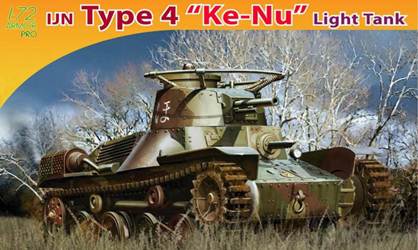
- This
Dragon kit number 7404 of the Type 4 “Ke-Nu” I have
little information on, but I understand that it is a late variant
of which only about 25 were built and it never saw combat. It is
essentially a Type 95 Light Tank with a turret from the Type 97
“Chi-Ha” tank”, with a low velocity 57-mm gun,
from Dragon Model’s kit #7397.
- The
box art shows a tank in what appears to be a 3-color camouflage
and with Japanese markings on the turret side. The wider turret
has the frame antenna like that found on the Type 97.
-
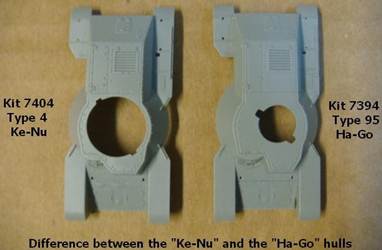
The hull appears to be a variation of the riveted Type 95 tank hull
found in Dragon kits 7394 and 7402. In this photo supplied by Ken
Overby (via Henk of Holland) the Type 4 hull features a larger turret ring and modified
forward upper hull.
The Parts
There are approximately 35 gray injection-molded, styrene plastic
kit parts, plus two band tracks and a small etched brass fret with
a mesh screen for the muffler.
- These
parts below are from Type 95 kit 7402. The hull appears to be the
same riveted tank hull found in Dragon kits 7394. I assume that
review comments for this model kit would also count for the other
two model kits.
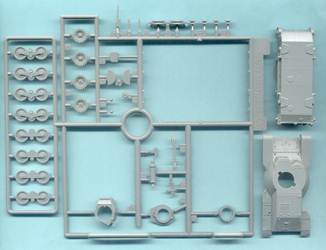
- Above,
from kit 7402, are the single Sprue-A and the individual slide-molded
lower hull (part C) and upper hull (part B). Parts are crisply molded
and with top-notch detail. At the upper right of Sprue-A is a large
hole where the bell-suspension parts for kit 7394 have been cut
out by Dragon before the box was sealed.
- At
the very top we see the 37-mm and the machine gun barrels (parts
A3, A4 & A5) and the slide-molded idlers (parts A2) and return
roller wheels (parts A1).
- At
far left are the sixteen roadwheels paired on eight bogie parts
(parts A21 and A22) to make four bogie assemblies. These roadwheels
are removed from the kit 7394.
- At
bottom are the two turret parts (A18 & A20) and the cupola (A19).
This appears to be the same turret as in Dragon kit 7394.
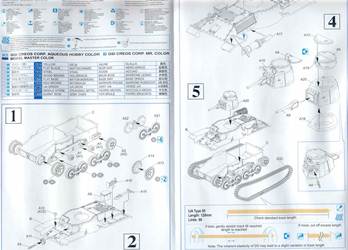
- Dragon’s
instructions from Kit 7404 are typical of their kits: multi-color,
broken into five steps, and clear and understandable. At upper left
is a paint color conversion chart.
- At
lower right are directions for working with Dragon’s DS material
band tracks, including comments on gently stretching the track material.
(Sometimes Dragon DS plastic tracks can be too tight and need to
be stretched out.)
- The
assembly instructions for kits 7394 and 7404 are the same except
for a different suspension (kit 7394) or turret (kit 7404).
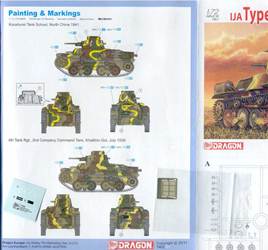
- Here
is the typically nice 3-view painting guide from kit 7402 for two
Japanese type 95 tanks serving in Manchuria (North China) in 1939
and 1941.
- At
lower left is the small water-slide decal sheet with markings for
two Type 95 tanks
- At
lower right is the small etched brass fret with the engine muffler
screen.
Conclusion
I found this a well-detailed and accurate model kit and a welcome
addition to Braille Scale.
With such a small model and with so few parts it would be great to
have included two tanks in the box like with Dragon’s Sd.Kfz.222
armored car kit. Imperial Japanese Army or Marine crew figures would
be greatly appreciated.
REFERENCES
- Tank
Warfare On Iwo Jima, by David Harper, Squadron Signal Publications
(2008). ISBN978-0-89747-559-4
- Tank
Battles of the Pacific War 1941-1945, Armor At War Series 7004,
by Steven J. Zaloga, Concord Publications Co. (1995) ISBN 962-361-607-4
- Taki
IMPERIAL JAPANESE ARMY PAGE website:
http://www3.plala.or.jp/takihome/ha-go.htm
and
http://www3.plala.or.jp/takihome/ke-nu.htm
a
- Henk
of Holland website.
|